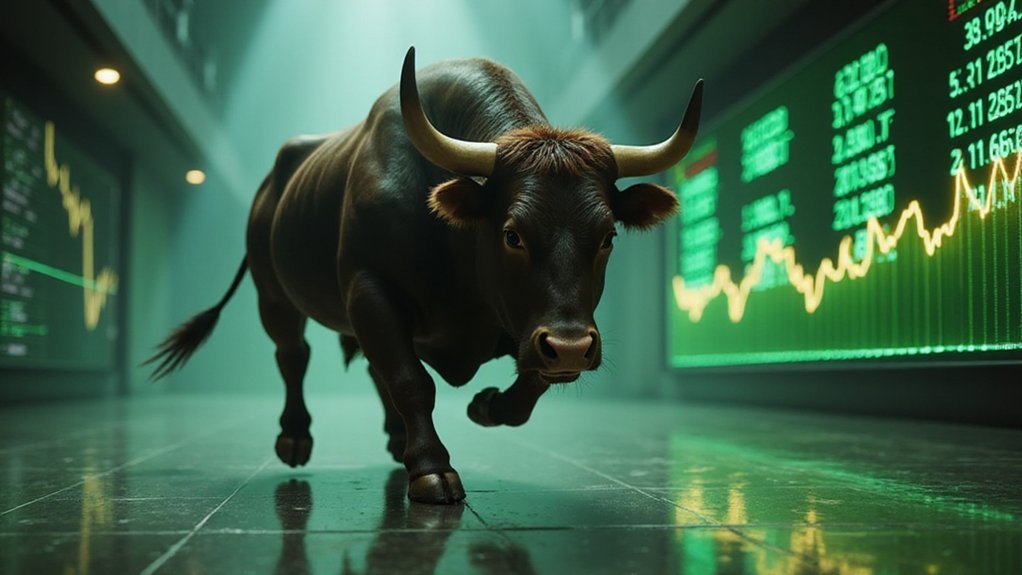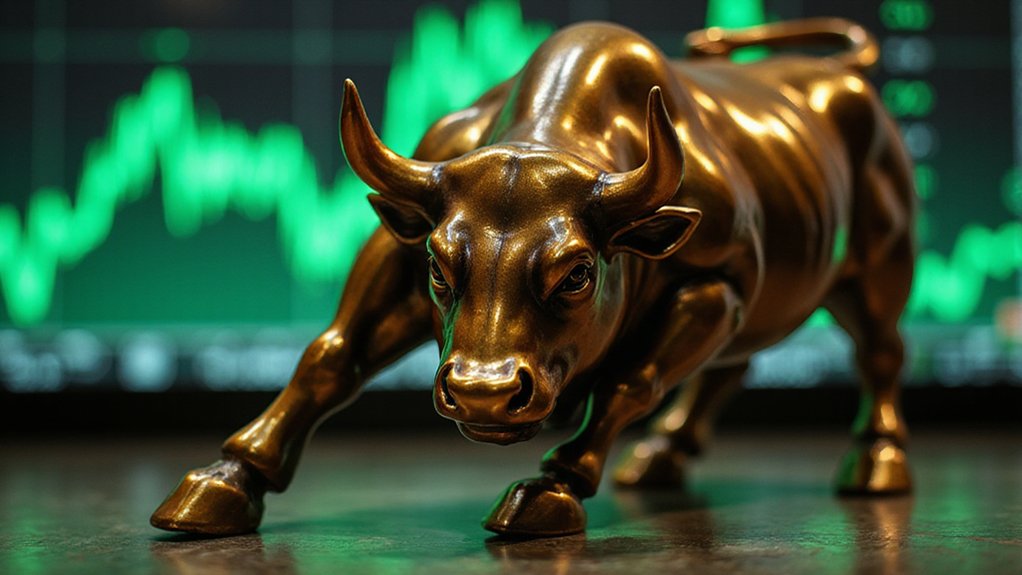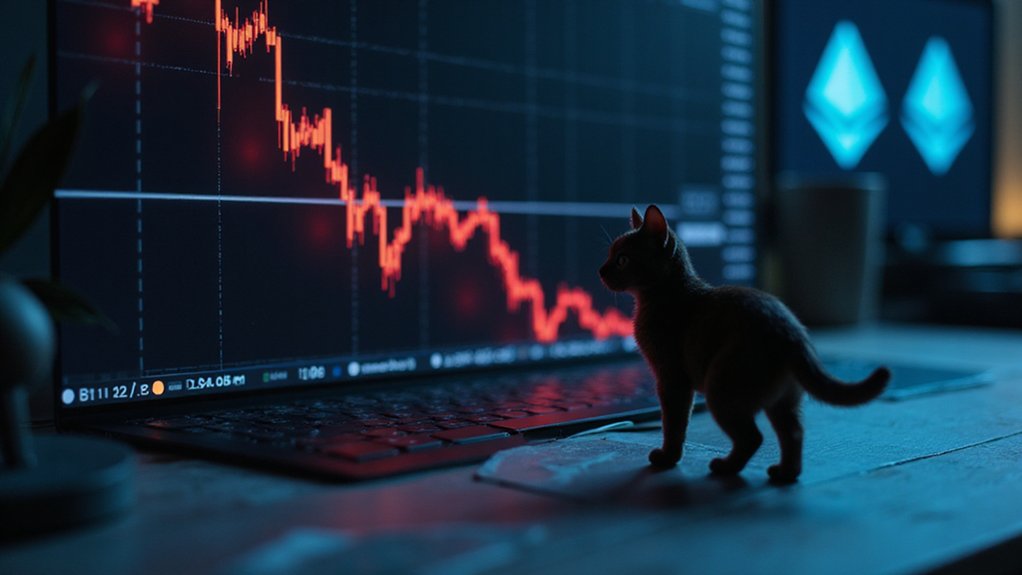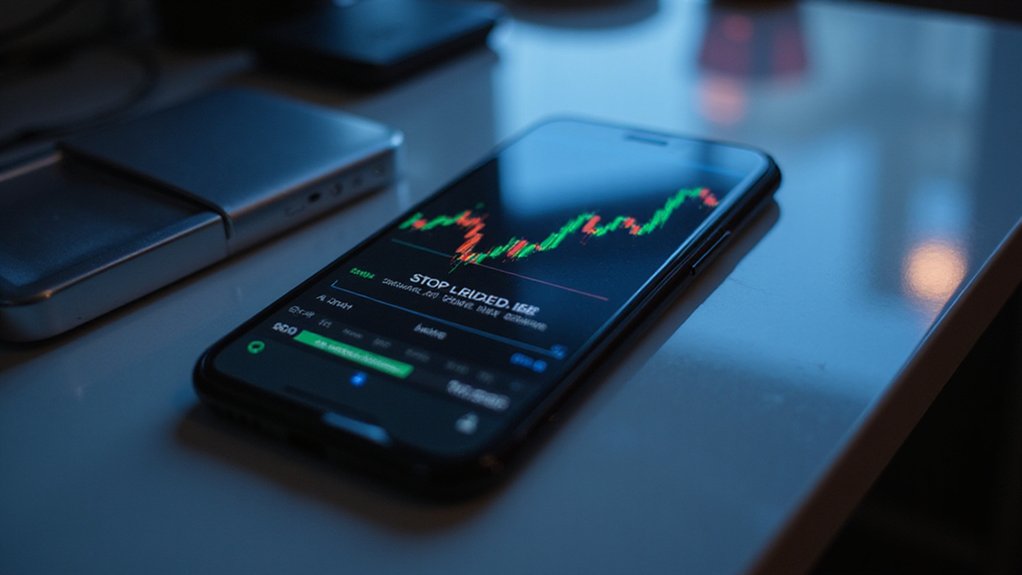A bull run marks a sustained market uptrend characterized by major indexes climbing at least 20% from recent lows—a financial stampede fueled by robust economic fundamentals and psychological optimism. This charging phenomenon occurs when buyers consistently outnumber sellers, stretching P/E ratios beyond historical norms while employment rates and corporate profits simultaneously expand. The pattern typically persists for approximately four years, rewarding patient investors while quietly germinating the seeds of its eventual reversal.

How often has a thriving market been equated with the charging force of a bull? The metaphor aptly captures the aggressive upward momentum that defines a bull market—a sustained period where major indexes like the S&P 500 and Nasdaq rise at least 20% from recent lows.
This financial phenomenon, observable across various markets from equities to commodities, represents far more than mere numerical gains; it embodies a complex interplay of economic conditions, human psychology, and market mechanics.
The underpinnings of a bull run invariably trace back to robust economic fundamentals. With employment rates climbing, consumer spending surging, and corporate profits expanding, the ecosystem creates a self-reinforcing cycle of growth.
Bull markets thrive on economic vitality, propelling a self-sustaining cycle where rising employment, consumption, and profits continually reinforce growth.
Companies, flush with revenue, reinvest in operations, further fueling economic expansion—a virtuous circle that, when functioning ideally, can sustain itself for surprisingly extended periods (the average bull market persists for approximately four years, dwarfing its ursine counterpart). The longest bull market in history stretched from 2009 to 2020, demonstrating the remarkable staying power of these economic cycles. This growth period delivered an impressive 180% average rise compared to the 36% average loss seen in bear markets.
At its core, a bull market is fundamentally a question of supply and demand. When buyers outnumber sellers, bidding wars ensue, driving share prices skyward and occasionally stretching P/E ratios beyond historical norms.
This imbalance, propelled by investor confidence, creates that most potent of market forces: momentum.
The psychological dimension cannot be overstated. Bull markets feed on optimism—a collective belief that tomorrow’s prices will exceed today’s.
This sentiment, once established, attracts additional capital, reinforcing the upward trajectory in a feedback loop that can occasionally border on irrational exuberance.
Savvy investors recognize bull markets as opportunities rather than guarantees. The “buy and hold” strategy often proves effective during these periods, though selective acquisitions during temporary retracements can enhance returns. Bull markets are typically associated with high investor confidence and robust economic growth that creates favorable conditions for various investment strategies.
The true challenge lies not in participating in a bull market but in discerning its eventual conclusion—that inflection point where sentiment shifts and the charging bull finally exhausts itself.
Frequently Asked Questions
How Long Does a Typical Bull Run Last?
The duration of a typical bull run varies considerably by market type.
Broad U.S. equity bull markets average around 9.6 months but can extend to multiple years (with post-recession rallies occasionally stretching beyond a decade).
The tech-heavy Nasdaq averages longer cycles of approximately 3.8 years, while cryptocurrency bull runs typically last about 8 months—though with notorious volatility.
These timeframes, inevitably influenced by economic fundamentals and investor psychology, remain frustratingly inconsistent across market cycles.
Can Individual Investors Profit During a Bull Market?
Individual investors can indeed profit during bull markets through various strategies: buying growth stocks with expansion potential, following momentum behind upward-trending securities, rotating into hot sectors, and using technical analysis to identify entry points.
Success, however, requires discipline—avoiding the siren song of overvalued darlings and maintaining diversification against inevitable corrections.
While professional investors may enjoy informational advantages, retail participants who combine strategic stock selection with proper risk management can capture substantial portions of bull market gains.
What Triggers the End of a Bull Run?
Bull runs typically end through a perfect storm of converging factors: economic weakness (declining GDP, rising unemployment), monetary tightening as central banks raise interest rates, deteriorating market internals (narrowing breadth, sector rotation failures), and shifting investor psychology from greed to fear.
These elements rarely appear in isolation—rather, they cascade and amplify each other’s effects.
The technical breakdown often precedes the fundamental story, with weakening market breadth serving as the canary in the proverbial coal mine.
Are Bull Runs Predictable Using Technical Analysis?
Technical analysis offers probabilistic—rather than deterministic—insights into bull runs.
While indicators like RSI, golden crosses, and chart patterns can signal momentum shifts, their predictive power varies considerably.
Markets, adapting organisms that they are, often render yesterday’s reliable signals today’s false positives.
The judicious analyst combines technical tools with fundamental analysis and macroeconomic context, acknowledging that no methodology captures the full complexity of market psychology, exogenous shocks, and institutional behavior.
How Do Interest Rates Affect Bull Market Momentum?
Interest rates profoundly impact bull market momentum, often acting as both architect and executioner of market rallies.
Rising rates initially may accompany bull markets during economic recoveries, yet they simultaneously increase borrowing costs, reduce corporate profitability, and enhance bond attractiveness relative to equities.
The hazard rate for bull market termination increases substantially with rate hikes, particularly in early stages, while seasoned bull markets demonstrate greater resilience.
Central bank decisions therefore function as critical inflection points—choreographing the delicate dance between economic growth and market exuberance.









